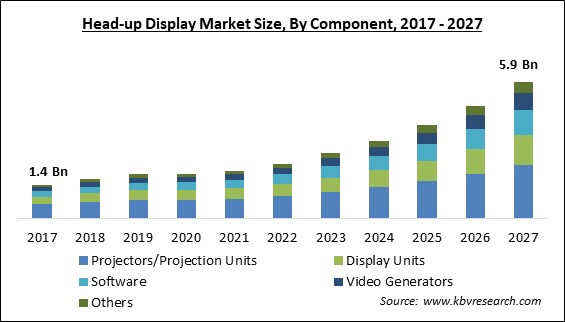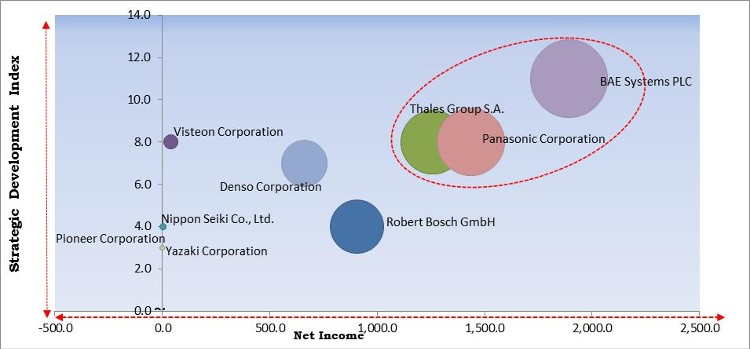The Global Head-up Display Market size is expected to reach $5.9 billion by 2027, rising at a market growth of 19.2% CAGR during the forecast period.
A projection system that displays a brightly lighted video or image onto a clear surface is known as a head-up display. The main purpose of a head-up display is to reduce the requirement for drivers to shift their sight from the road to the entertainment panel. These displays project information like turn-by-turn navigation, current speed, posted traffic signs, and blind-spot alerts directly into the field of view of the drivers or pilots, allowing them to keep their gaze forward, where danger lurks. Head-up displays were developed for defense and military aircrafts, but their use in several high-end vehicles has gained popularity in recent years.
When it comes to purchasing a vehicle, today's car buyers are increasingly considering innovative automobile safety features and technologies. Monitoring numerous in-vehicle displays might cause the driver to become distracted, perhaps resulting in dangerous circumstances on the road. A HUD, which is enabled by both passive and active systems, lowers driver distraction while also increasing driving safety. Additionally, ongoing technical advancements have resulted in the emergence of mobile and interactive HUDs, which is propelling the overall market growth.
In the near future, augmented reality head-up displays will aid in making driving safer and more comfortable. As part of the shared, autonomous future, Jaguar Land Rover stated in August 2019 that it is designing next-generation HUD technology that may beam real-time safety warnings in front of the driver and enable passengers to broadcast 3D movies directly from their seats.
Moreover, in several developed economies, government regulations are progressively supporting automotive advances and technologies that assist vehicle and road safety. Automated Cars 3.0, the latest federal advice for automated vehicles, was released in October 2018 by the United States Department of Transportation (USDOT). The USDOT's commitment to promoting the safe incorporation of automation with the overall transportation system was reaffirmed in AV 3.0.
Rising automotive manufacturing and developments such as linked vehicles and driverless vehicles are expected to increase HUD adoption and demand throughout the forecast period. HUDs are commonly employed in both military and commercial aircraft because they assist pilots and reduce the risk of colliding with the landscape. The market's growth is predicted to be aided by rising military spending and the increasing deployment of HUDs in civil aircraft.
Additionally, an increase in air passenger traffic is expected to lead to an extension of the worldwide aircraft fleet, which will increase demand for HUDs in the civil aviation industry in the future years. According to estimates issued by the International Civil Aviation Organization (ICAO), air transportation handled 4.3 billion passengers on scheduled trips in 2018. This represents a 6.1% increase over 2017. The number of people leaving the country increased to almost 38 million.

The COVID-19 outbreak caused a significant downfall to various economies all over the world. The outbreak of the novel coronavirus slowed down numerous businesses globally. In addition, due to the rapid spread of the infection, governments were forced to impose countrywide lockdowns. Due to the travel restrictions under the lockdown, the supply chain of various goods, as well as intermediate goods, was significantly disrupted. Moreover, the lockdown also caused a considerable hindrance to various manufacturing facilities worldwide. Due to this, the world economy was majorly disrupted. The COVID-19 pandemic had a significant impact on the growth of the head-up display market. The distribution of components used in the manufacturing of head-up displays was disrupted, with most research and development efforts as well as new product releases connected to head-up displays being delayed or canceled due to the pandemic.
Vehicle buyers place an emphasis on the safety of vehicles and passengers. Regulatory agencies all over the world are working in order to improve car safety. According to a global status report on road safety released in 2019, more than 1.35 million people die every year as a result of traffic accidents on roads around the world. According to studies, road traffic causalities can become the world's fifth-biggest cause of death by 2030. One of the leading causes of these collisions is driver distraction. Drivers' vision must acclimatize to a vast visual distance on the road after reading the instrument clusters. After reading the standard instrument clusters, the eyes must focus on the road. Drivers' eyes become tired and lose attention as a result of the frequent shifts in focus. In this context, head-up displays provide vital information in the line of sight of drivers, such as navigation and vehicle speed, reducing driver distraction.
In recent years, there has been a considerable surge in global demand for electric and semi-autonomous automobiles. The growing popularity of these vehicles is driving the demand for head-up displays. Semi-autonomous vehicles can detect their surroundings and travel to their destination with only minimal human intervention. Voice instructions can be used to control this type of vehicle. The primary purpose of these vehicles is to improve driving safety and convenience. Front collision avoidance, park assistance, and adaptive cruise control are among the advanced features available in semi-autonomous vehicles. The head-up displays that are used in semi-autonomous vehicles offer these features on the windshield in the line of sight of the driver.
By visually displaying concurrent traffic conditions for drivers, advanced head-up displays, like AR-based head-up displays, make driving extremely comfortable and safe. Head-up displays that are mounted on the windshield of the vehicle, on the other hand, take up a lot of room in car cockpits. Due to the significant space occupied by AR-based head-up displays on automobile dashboards, several efforts are underway to re-design automotive cockpits. Any reduction in the size of AR-based head-up displays can to lower the sharpness of augmented images and hence, make them less legible for drivers. In addition, iris recognition and gesture control systems must be placed in vehicles with head-up displays to ensure that projections are accurate in the visual field of drivers.

Based on Application, the market is segmented into Automotive (Passenger Cars and Commercial Vehicles) and Aviation (Civil and Military). In 2020, the aviation segment recorded a significant revenue share of the head-up display market. HUD technology is extremely useful in the aviation industry, with a HUD serving as the primary means of displaying crucial information to pilots. For many years, HUD has provided services to the military, defense, and civil aviation sectors. Commercial airplanes have recently begun to use the HUD technology. Due to the increasing utilization of this technology in airplanes, the market is observing significant growth. Hence, the demand for head-up displays is increasing across the aviation industry. Therefore, this segment is anticipated to accelerate the growth of the head-up display market.
Based on Type, the market is segmented into Conventional and Augmented Reality (AR)-based. In 2020, the conventional segment garnered the largest revenue share of the head-up displays market. As a result of the HUD system's inexpensive installation cost and the increased prominence of vehicle and passenger safety systems across automotive consumers, the utilization of this technology is rapidly increasing. Moreover, the adoption of traditional HUD by major car manufacturers to provide a better and more transparent picture of the surroundings is expected to increase the growth of the head-up display market.
Based on Component, the market is segmented into Projectors/Projection Units, Display Units, Software, Video Generators and Others. In 2020, the display unit segment procured a substantial revenue share of the head-up display market. Vital information, like the car's speed, is usually displayed on head-up display units. If the automobile, or any other vehicle that comprises an integrated head-up display, has a built-in navigation system, the driver can receive guidance regarding directions, as well as information like current gear, revs, and fuel level, to be displayed on the HUD. While head-up display technology has evolved in recent years, the images on infotainment screens or digital dashboards are likely to be of high quality. These factors are accelerating the growth of this segment.
| Report Attribute | Details |
|---|---|
| Market size value in 2020 | USD 1.9 Billion |
| Market size forecast in 2027 | USD 5.9 Billion |
| Base Year | 2020 |
| Historical Period | 2017 to 2019 |
| Forecast Period | 2021 to 2027 |
| Revenue Growth Rate | CAGR of 19.2% from 2021 to 2027 |
| Number of Pages | 278 |
| Number of Tables | 513 |
| Report coverage | Market Trends, Revenue Estimation and Forecast, Segmentation Analysis, Regional and Country Breakdown, Competitive Landscape, Companies Strategic Developments, Company Profiling |
| Segments covered | Type, Component, Application, Region |
| Country scope | US, Canada, Mexico, Germany, UK, France, Russia, Spain, Italy, China, Japan, India, South Korea, Singapore, Malaysia, Brazil, Argentina, UAE, Saudi Arabia, South Africa, Nigeria |
| Growth Drivers |
|
| Restraints |
|
Based on Regions, the market is segmented into North America, Europe, Asia Pacific, and Latin America, Middle East & Africa. Europe emerged as the leading region in the head-up display market with the largest revenue share in 2020. Europe comprises one of the largest automotive industries in the world. Europe is regarded as the world's leading luxury/premium automotive manufacturing region. Audi AG, BMW AG, Mercedes-Benz, Bentley Motors Ltd, Maserati, Skoda Auto, Ferrari and Bugatti Automobiles S.A.S are some of the high-end vehicle manufacturers that are operating in this region. Because head-up displays are one of the most important safety features, most luxury and premium car manufacturers in Europe include them in their models. The market in Europe is predicted to increase due to rising demand for a premium or luxury automobiles and SUVs integrated with head-up displays.
Free Valuable Insights: Global Head-up Display Market size to reach USD 5.9 Billion by 2027

The major strategies followed by the market participants are Product Launches. Based on the Analysis presented in the Cardinal matrix; Thales Group S.A., BAE Systems PLC and Panasonic Corporation are the forerunners in the Head-up Display Market. Companies such as DENSO Corporation, Pioneer Corporation, Yazaki Corporation are some of the key innovators in the Market.
The market research report covers the analysis of key stake holders of the market. Key companies profiled in the report include Visteon Corporation, Nippon Seiki Co., Ltd., Robert Bosch GmbH, Continental AG, Denso Corporation, Pioneer Corporation, BAE Systems PLC, Panasonic Corporation, Thales Group S.A., and Yazaki Corporation.
By Application
By Type
By Component
By Geography
The head-up display market size is projected to reach USD 5.9 billion by 2027.
Rising concerns about road safety are driving the market in coming years, however, limited space in the automotive cockpit limited the growth of the market.
Visteon Corporation, Nippon Seiki Co., Ltd., Robert Bosch GmbH, Continental AG, Denso Corporation, Pioneer Corporation, BAE Systems PLC, Panasonic Corporation, Thales Group S.A., and Yazaki Corporation.
The Automotive segment acquired the maximum revenue share in the Global Head-up Display Market by Application in 2020, thereby, achieving a market value of $3.5 billion by 2027.
The Projectors/Projection Units segment is leading the Global Head-up Display Market by Component in 2020, thereby, achieving a market value of $2.2 billion by 2027.
The Europe market dominated the Global Head-up Display Market by Region in 2020, and would continue to be a dominant market till 2027.
Our team of dedicated experts can provide you with attractive expansion opportunities for your business.

